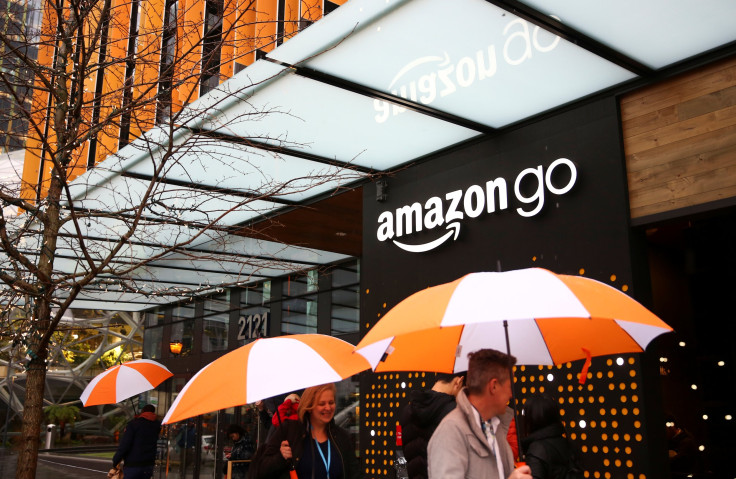Why Would Amazon Want To Open 3,000 Cashier-Less Stores?

Amazon (NASDAQ:AMZN) recently opened its fourth Amazon Go convenience store, and the online retail giant may expand its cashier-less store concept to 3,000 locations by 2021, according to a report from Bloomberg.
The article originally appeared in The Motley Fool.
If it happens, that expansion would make Amazon one of the largest convenience store chains in the nation, trailing just 7-Eleven and Circle K. Many of the locations would reportedly focus on ready-made food, which would make the new stores a bigger threat to fast-food and fast-casual restaurants than supermarkets or drugstores.
Still, an investment in 3,000 stores is going to cost Amazon a lot. Its first location reportedly required $1 million in camera and AI technology alone. So, why is Amazon so interested in growing Amazon Go?
A $3 billion investment
Amazon could spend as much as $3 billion on Amazon Go locations if it proceeds to open 3,000 stores, according to an analysis by Morgan Stanley's Brian Nowak that was reported by Bloomberg. He said Amazon could potentially reach that scale for as little a $0.5 billion, but it's much more likely to spend closer to $3 billion than that low-end estimate.
At least one estimate puts an Amazon Go store's annual revenue at $1 million to $2 million. The focus on prepared foods over groceries and convenience items should enable it to generate a higher gross margin than Amazon's core online retail business or its Whole Foods Market locations. Concentrating store locations in urban areas with Whole Foods locations nearby could perhaps enable it to boost those margins by using kitchens at Whole Foods to prepare meals and deliver them to Amazon Go locations around the city.
Three thousand Amazon Go locations could generate $3 billion to $6 billion in annual revenue, according to Baird Equity Research analyst Colin Sebastian. He expects that to produce $1 billion to $2.5 billion in gross profits, according to a Business Insider report. Sebastian doesn't expect to see much of those gross profits fall to the bottom line, though, considering the expenses associated with opening and running the stores.
In other words, Amazon could invest billions of dollars on a project that will produce a small amount of revenue and an even smaller amount of profits.
Amazon isn't looking for profits
Investors familiar with Amazon know that it doesn't always create products with the intent of making a direct profit. Amazon routinely sells its devices like the Echo Dot, Fire TV stick, and Fire tablet below cost just to get them into consumers' households. Those devices provide Amazon with lots of data and various opportunities to sell ancillary products and services to consumers.
Amazon Go may be yet another way to gather data on consumers. Every time someone walks into an Amazon Go location, they scan an app on their smartphone, which allows the cameras to link a person to an online account for billing. The store keeps a running tab as you take items off the shelf (and subtracts them if you put the item back).
While many stores offer a loyalty program that allows them to track what consumers buy, Amazon Go's technology can take that sort of data to the next level. It can tell exactly how many milliseconds a person considered buying an item, which items they considered and left on the shelf, and whether a customer chose one item over another option.
Amazon can then take that data to make product recommendations the next time a customer logs into Amazon. It could also target promotions to certain customers based on their shopping behavior in stores, enabling it to grow its burgeoning ad business even faster.
Alibaba (NYSE:BABA) has taken a similar approach with its cashless Hema supermarkets in China. Alibaba introduced the Hema concept in 2015, and it uses customer data to make personalized recommendations through its app. It also uses data to optimally stock its stores. Alibaba may eventually use customer data to offer personalized recommendations on its online marketplaces, Taobao and Tmall, or its food delivery app, Ele.me.
Both Nowak and Sebastian note the data could enable Amazon to take a greater share of customer spending over time by offering more targeted and timely product recommendations through its online presence.
Amazon is going to take some time to test Amazon Go. It's only going to open 10 stores by the end of this year, and 50 by the end of next year, according to the Bloomberg report. But if the early tests go well, Amazon will scale quickly, just as it's done with other businesses. So, if Amazon is suddenly ramping up spending and opening dozens of Amazon Go stores per week, take it as a good sign.
John Mackey, CEO of Whole Foods Market, an Amazon subsidiary, is a member of The Motley Fool's board of directors. Adam Levy owns shares of Amazon. The Motley Fool owns shares of and recommends Amazon. The Motley Fool has a disclosure policy.





















